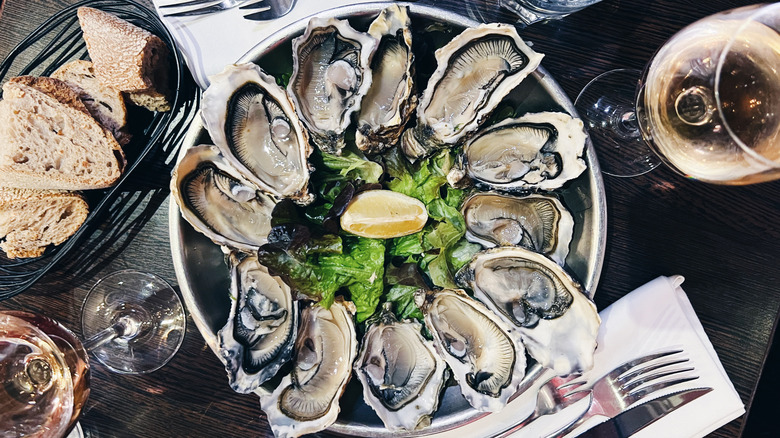Where To Find The Adductor In Fresh Oysters (And How To Cut It)
Shucking an oyster can be tricky if you haven't done it before. However, with a little know how, it's possible to do it neatly with as little fuss as possible in two simple stages. After you've inserted your knife into the hinge of the shell and popped it open, the final stage is to locate and cut away something called the adductor, which is found on the right hand side of the shell.
The adductor is a muscle inside an oyster, which clasps its shell shut whenever it's threatened, creating a tight seal. It can be found on the right side of an oyster when you're holding it with the hinge facing toward you and it's curved side cupped in your palm. The strength of this muscle, which is the only thing connecting the top and bottom shells together, is why it can prove so tricky to prize open an oyster by hand.
A sharp knife or shucking knife, like this no-slip handled option available on Amazon, is a must to cut away the adductor, which is comprised of two parts — the "quick" that the oyster uses to open and close itself and the "catch" that keeps it shut. To cut the adductor you'll first need to slide your knife into the small gap along the side where the two shells meet and run it along the top shell to release its grip. Once the top shell is removed, drag your knife under the bit of the adductor that's tethered to the bottom shell to release the flesh in full.
Broil oysters to relax and release their adductor muscles
If you're worried about shucking an oyster with a particularly tight seal, consider popping it under your broiler for a few minutes. A quick broil is the secret to oyster shucking because a blast of high heat causes the adductor muscle to relax, which opens the shell up just enough to get the tip of a knife inside more easily. The key is to remove the shells as soon as they open up so your oysters retain as much of their raw seafood flavor as possible. Once you've released the adductor from the shell, you can devour an oyster whole with its briny juice as is or top it with a dressing.
The most traditional of oyster dressings is known as a shallot mignonette sauce, which is a mixture of finely chopped shallots, vinegar, and pepper, however, feel free to customize your vinaigrette by adding anything from horseradish and honey to a splash of Tabasco and ginger. One unexpected ingredient that can upgrade raw oysters is kimchi because it lends spice and acidity to the oceanic quality of the tender flesh and juice. On the other hand, you may prefer to steam, bake, or even deep fry your oysters after coating them in seasoned panko to make the fixings for a fancy po' boy.

